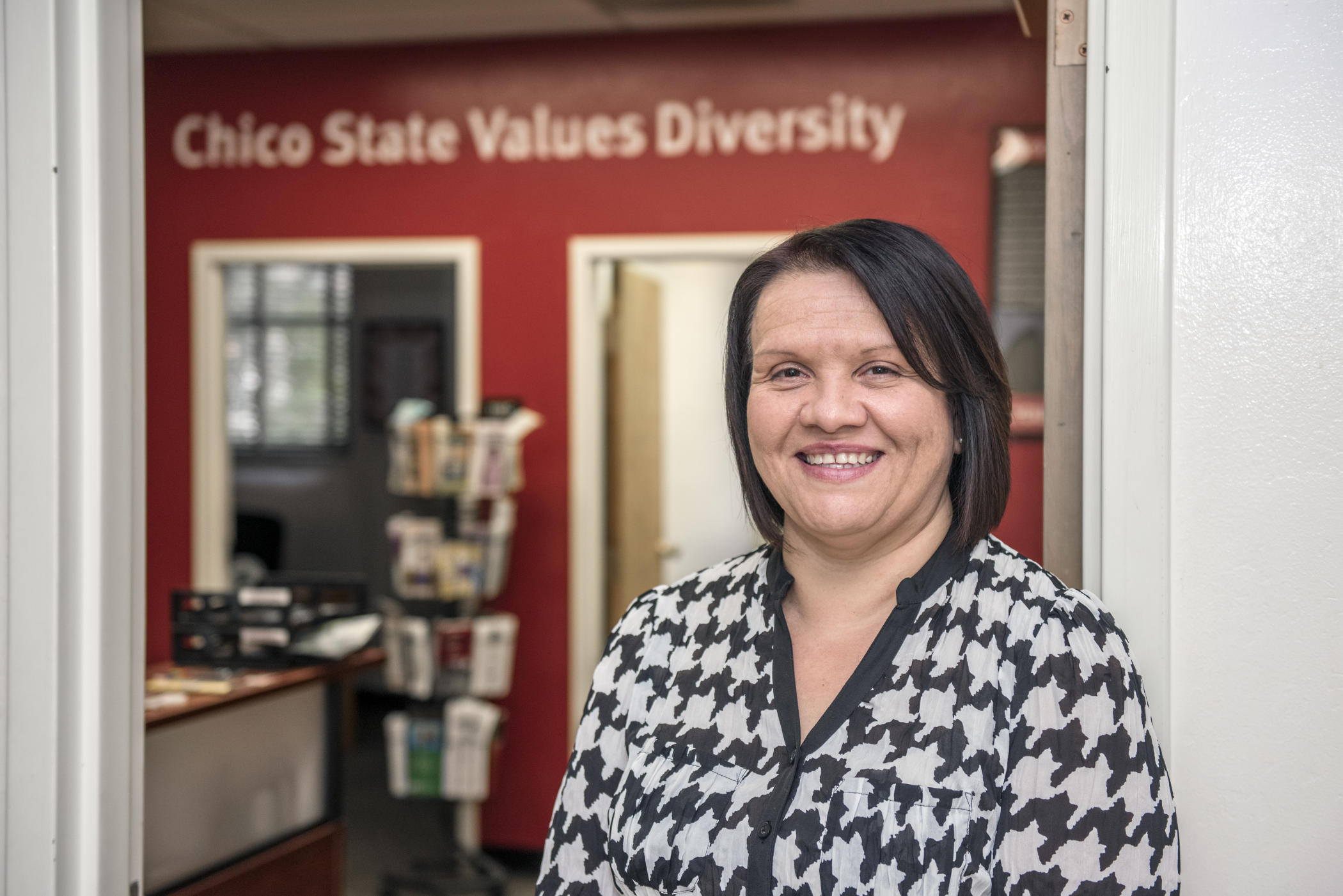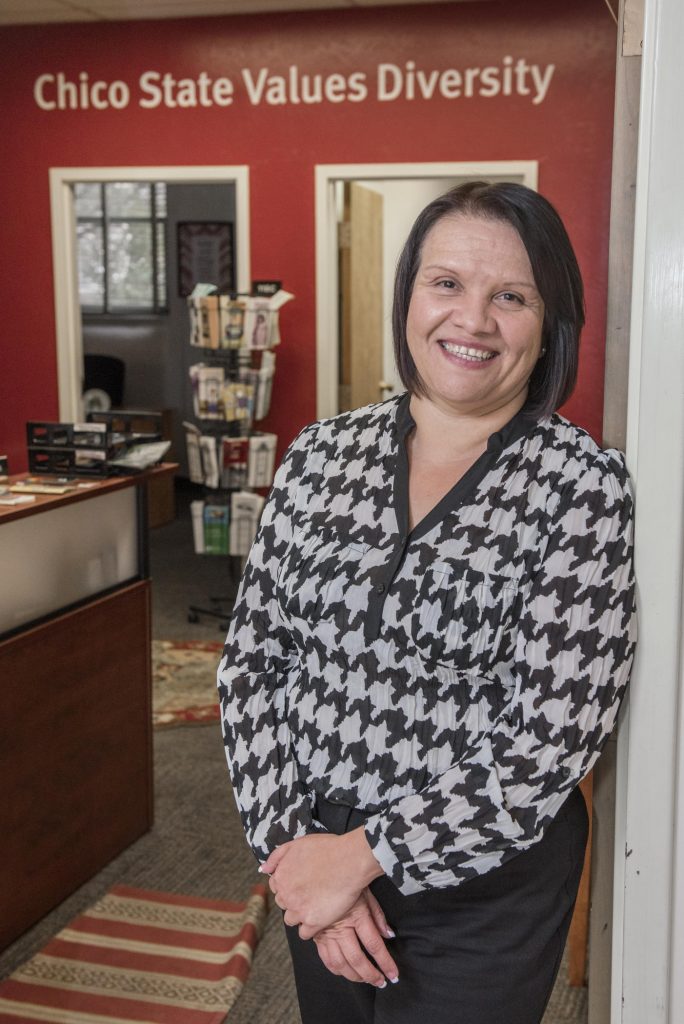Becoming a Hispanic-Serving Institution

A conversation with Teresita Curiel
In fall 2014, the University reached an important milestone: 25 percent of enrolled students were Hispanic or Latino. This semester, that percentage grew to 28. To assist with the myriad implications of this historic achievement, President Paul Zingg announced in October that Teresita Curiel (BA, Mathematics, ’00; MA, Education, ’09), recent assistant director of admissions and outreach, had been appointed the University’s interim assistant director of Hispanic-Serving Institution initiatives in the Office of Diversity and Inclusion (a new position).
We sat down with Curiel to talk about her new role and its significance to campus.
First, what does it mean to be a Hispanic-Serving Institution (HSI)?
It means a few different things. For student services professionals, it means we’re being responsive to the needs of Latino students. We’re going to be an institution that’s more than just Latino-student-enrolling, but one that’s actually serving our campus community, in which Latino students play a significant role.
Now, the Hispanic Association of Colleges and Universities (HACU) has a definition as well: any institution for higher education that has at least 25 percent Latino undergraduate student enrollment.
Probably the one that’s going to get most attention on our campus, however, is achieving the federal designation as an HSI, which implies eligibility for Title III and Title V grants through the U.S. Department of Education. We have to be an HSI by enrollment numbers; we also have to meet a certain profile with respect to the financial status of our students (at least half of all our students must be receiving federal financial aid); and there’s a fiscal requirement that our funding is average, if you will, for four-year public universities.
So those are the different angles of the HSI definition. My role is to balance all three, and to communicate and create awareness about them.
Why is it important to achieve this distinction?
For me, it’s important because the face of the student body has changed significantly at Chico State. Just five years ago we were at 15 percent Latino enrollment; we’ve almost doubled (that percentage) in that time. We could have a separate conversation about why that is, but the reality is: They’re here. They’re on our campus. They’re choosing Chico State. So we need to be responsive to them.
What do you hope to accomplish in your new role?
I’m an alumna, and I began working here directly after graduating. So I’m “Wildcat” inside and out. And I’ve had the benefit of seeing this evolution happen right in front of my eyes.
My professional background is in creating opportunities for underrepresented students to have access to college opportunities. I worked many years for the College of Engineering, Computer Science and Construction Management in the areas of science, technology, engineering and mathematics (STEM). Then, a month ago, I stepped out of my role in the Office of Admissions, where for several years I was the assistant director for admissions and outreach. So I have a very strong relationship with schools and colleges in our local service area. I also have a deep understanding of what’s happening on our campus.
And thirdly, I’m Latino myself. So I have a unique sensitivity toward Latino students, the culture, and perhaps the challenges and benefits they may or may not have when they come here.
Has your own experience as Hispanic student at Chico State influenced your work here?
I think yes, because I’m hard-wired to do diversity work. I came here and majored in mathematics. So I was highly underrepresented in my field: Not only was I often the only woman in my classes, I was the certainly the only student of color. It was out of my own personal experience that I got interested in education but still with this thread of creating opportunities for students who have been historically underrepresented in higher education—to open the doors for them so they can also do what many of us have done here.

What are some first steps for you?
One of the first steps is outreach and communication—we want to be very transparent about the work related to the HSI designation and create a lot of awareness for faculty, staff, and students—while simultaneously researching and benchmarking institutional statistics.
Then, a lot of it is researching our eligibility to apply for the designation so we’ll be able to compete for the grants. The criteria have changed from last year, and there are a lot of check marks: Do we have this? Do we have that?
Then we need to know: What is it we want to go after? What do we want to write into our grants? Where do we think we can best leverage our resources? What are the areas of most need or opportunity? It’s not just about student services but about what’s going on in the classroom. So we’re looking at what can be done from the faculty perspective and how we can assist faculty in being more responsive to students.
How can the rest of campus help the University reach its goals in this area?
There are a few things: Engage in opportunities for dialogue that will happen in the spring, and understand and engage with the work being done by the University Diversity Council. This is but one of the things they’re working on. Understand what it means in their space, and what can happen in their scope of influence.
While the resources in these grants are significant and will impact Hispanic students tremendously, the aim is to enhance everyone’s experience. It really is an opportunity for all students. I think that’s the most exciting part. It’s about being successful as an institution, both for the Latino student and the non-Latino student.
What else would you add about your role and this topic?
Having seen Chico State evolve, this is a really exciting time for campus. There are a slew of opportunities open now for us because we achieved 25 percent Hispanic enrollment. The federal designation is the big pie and will change how we do things in a very positive way. And I’m excited to have been selected.
But I’m not alone. My colleagues here in the Office of Diversity are also working on HSI considerations. The Chicano Latino Council has been a very strong advocate of this work, as are the folks who for 20, 30, or 40 years have been doing diversity work on this campus, whose work benefited me in my experience. And hopefully my work will benefit someone else’s experience.
The percentages are new, yes, and the opportunities because of the percentages, yes. But the work of diversity has been on this campus for a long time.
Interview by Sarah Langford.


